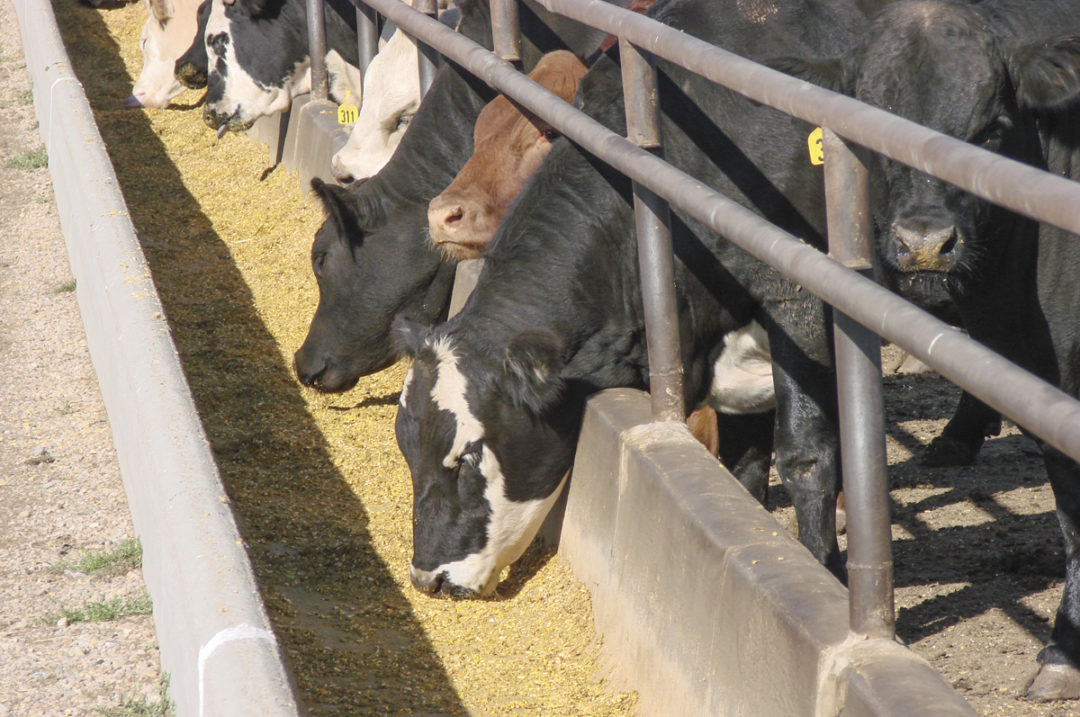Acidosis, also known as bloat, founder or sticking an animal, is one of the most costly problems in the feedlot. Calves coming into the feedyard must learn how much, how fast and how often to eat without becoming acidotic. Hallmarks of acute acidosis are a high left side, long toes, poor-doing calves and sudden death.
The immediate symptoms are watery stools with white residue after it dries, increased rate of respiration, standing in water, rocking back and forth due to sore feet, kicking the belly, going off feed and, in extreme cases, death. The biggest challenge associated with subacute acidosis is that it is not easily detectable, yet it is quite costly due to performance losses.
Subacute acidosis is usually not pen-wide, so the pen of cattle will continue to eat while some individuals will go off feed or have reduced intakes, resulting in low pen intakes and lower-than-expected gains. Subacute symptoms are slightly depressed pen intakes, loose stools and a tight left side.
There are several causes of acidosis:
-
Changing from a high-roughage diet to a high-concentrate diet too quickly. This is the reason we use a series of step-up diets. Each diet is to be fed three to five days at a minimum. This gives the rumen bacteria (bugs) time to adapt to the higher-concentrate diet and prevents the bacteria from producing too much lactic acid during fermentation (digestion) of the feed.
-
The amount of concentrate fed can also be a problem. An example would be cattle that went through a huge temperature swing. Excessive heat depresses intakes; cooler temperatures promote normal intakes. When the temperature spikes, cattle may drop to about 30% of their previous intakes for several days (nothing you can do about that). If intakes are not managed correctly, the subsequent increase in intake when temperatures cool can cause acidosis. The increase in intake needs to be controlled to about 1.5 pounds of dry matter or approximately 3 pounds of feed as-fed per day.
- The rate of fermentation or digestion of a feed ingredient can also be a problem. A feedstuff with a fast rate of fermentation is commonly referred to as a “hot” feed and may contribute to acidosis. A good example of this is feeding byproducts, which ferment slower than rolled corn, which ferments slower than ground corn, wheat or barley. For this reason, never feed fine-ground corn to ruminants, especially not in a self-feeder.
Acidosis – both acute and subacute – can be prevented by feeding within 15 minutes of the same time every day and by having at least 12 inches of bunk space for finishing cattle or 24 inches for cows, receiving calves and cattle that are being limit fed. When transitioning from one ration to another, make sure the cattle have been on the previous ration for at least three days, that a storm or weather change is not predicted for the immediate future, and that the rations are blended for one to three days. For example, feed the new ration in the afternoon for two days, when the cattle are not as aggressive, and the current ration in the morning prior to completely transitioning to the next step-up ration. The cattle should have feed in front of them no less than 16 hours per day and no more than 20 hours per day, unless otherwise specified. Make sure the cattle are not sorting feed. This does not mean the bunks are slick; however, it does mean the cattle are not moving feed back and forth in the bunks, creating bare spots in the bottom of the bunk. This is one of the more common problems we see, due to the longer length of hay in the bunk.
By practicing good bunk management, observing the cattle and their stools, watching the weather and moving cattle through the diets according to the proper protocols, acidosis can be minimized. This will translate into improved performance and additional dollars for you and/or your customer.








